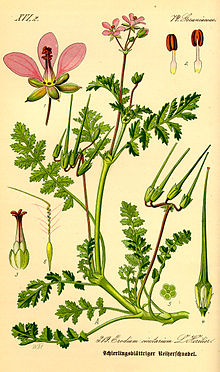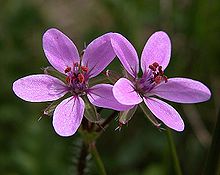- Erodium cicutarium
-
Erodium cicutarium 
Scientific classification Kingdom: Plantae Division: Magnoliophyta Class: Magnoliopsida Order: Geraniales Family: Geraniaceae Genus: Erodium Species: E. cicutarium Binomial name Erodium cicutarium
(L.) L'Hér.Erodium cicutarium, also known as Redstem filaree, Common Stork's-bill, is an herbaceous annual, and in warm climates a biennial member of the Geranium Family of flowering plants. It is native to the Mediterranean Basin and was introduced to North America in the eighteenth century,[1] where it has since become invasive, particularly of the deserts and arid grasslands of the southwestern United States.[2] The seeds of this annual are a species collected by various species of harvester ants.[3]
The entire plant is edible with a flavor similar to sharp parsley if picked young. The plant is widespread across North America. The plant grows as an annual in the northern half of North America. In the Southern areas of North America, the plant tends to grow as a biennial with a more erect habit and with much larger leaves, flowers and fruits. It flowers from May until August.
It is a hairy, sticky annual. The stems bear bright pink flowers, arranged in loose cluster, and often have dark spots on the bases. The leaves are pinnate and fern-like, and the long seed-pod, shaped very much like the bill of a stork, bursts open in a spiral when ripe, sending the seeds (which have little feathery parachutes attached) into the air.
Seed launch is accomplished using a spring mechanism powered by shape changes as the fruits dry [4] . The spiral shape of the awn can unwind during daily changes in humidity, leading to self-burial of the seeds once they are on the ground. The two tasks (springy launch and self-burial) are accomplished with the same tissue (the awn), which is hygroscopically active and warps upon wetting and also gives rise to the draggy hairs on the awn.
Common stork's-bill can be found in bare, sandy, grassy places both inland and around the coasts. It is a food plant for the larvae of the Brown Argus butterfly. According to John Lovell's "Honey Plants of North America" 1926, "the pink flowers are a valuable source of honey (nectar), and also furnish much pollen".
References
- ^ Mensing, S; R Byrne (1998). "Pre-mission invasion of Erodium cicutarium in California". Journal of Biogeography (Blackwell Science Ltd) 25 (4): 757–762. doi:10.1046/j.1365-2699.1998.2540757.x.
- ^ Stampe, NE (1984). "Self-burial behavioiur of Erodium cicutarium seeds". Journal of Ecology (British Ecological Society) 72 (2): 611–620. doi:10.2307/2260070.
- ^ Harmon, GD; NE Stamp (1992). "Effects of postdispersal seed predation on spatial inequality and size variability in an annual plant, Erodium cicutarium (Geraniaceae)". American Journal of Botany (Botanical Society of America) 79 (3): 300–305. doi:10.2307/2445019. JSTOR 2445019.
- ^ Evangelista, D; S. Hotton and J. Dumais (2011). "The mechanics of explosive dispersal and self-burial in the seeds of the filaree, Erodium cicutarium (Geraniaceae)". Journal of Experimental Biology (The Company of Biologists) 214 (4): 521–529. doi:10.1242/jeb.050567. http://jeb.biologists.org/cgi/content/abstract/214/4/521. Retrieved 2011-03-19.
Edible and Medicinal Plants of the West, Gregory L. Tilford, ISBN 0-87842-359-1 Honey Plants of North America, John H. Lovell, 1926
Image:Erodium cicutarium1.JPG|Erodium cicutarium Image:Erodium cicutarium2.JPG|Flower </gallery>
Categories:- Rosid stubs
- Geraniaceae
- Flora of the Mediterranean
- Invasive plant species
- Invasive plant species in California
Wikimedia Foundation. 2010.

